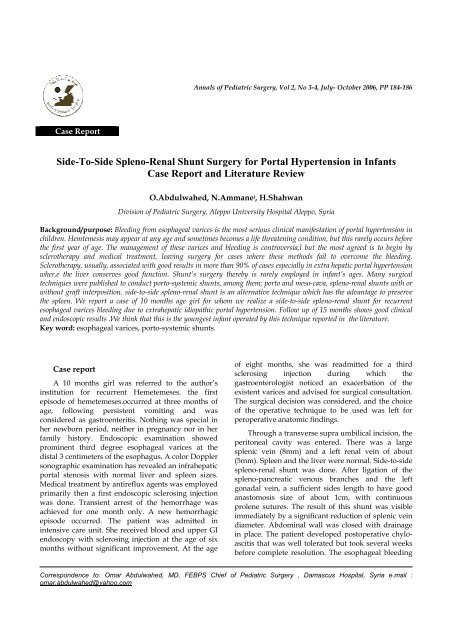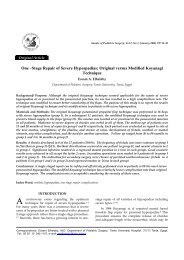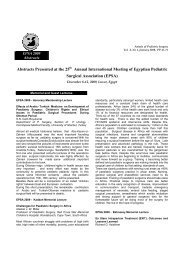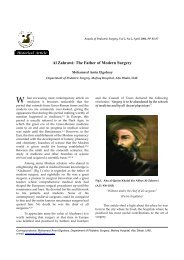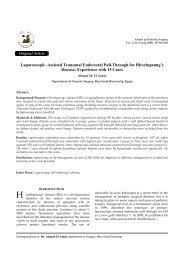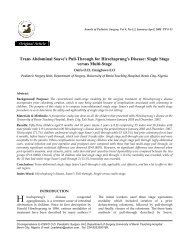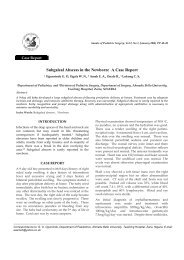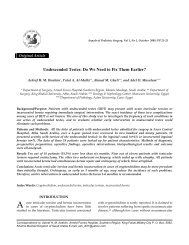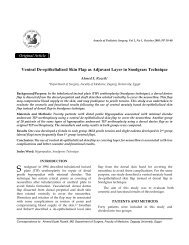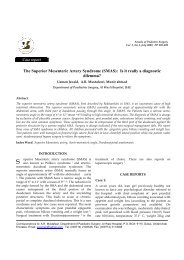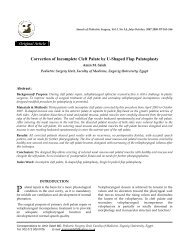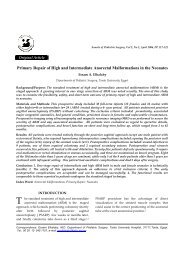Side-To-Side Spleno-Renal Shunt Surgery for Portal Hypertension ...
Side-To-Side Spleno-Renal Shunt Surgery for Portal Hypertension ...
Side-To-Side Spleno-Renal Shunt Surgery for Portal Hypertension ...
Create successful ePaper yourself
Turn your PDF publications into a flip-book with our unique Google optimized e-Paper software.
Annals of Pediatric <strong>Surgery</strong>, Vol 2, No 3-4, July- October 2006, PP 184-186Case Report<strong>Side</strong>-<strong>To</strong>-<strong>Side</strong> <strong>Spleno</strong>-<strong>Renal</strong> <strong>Shunt</strong> <strong>Surgery</strong> <strong>for</strong> <strong>Portal</strong> <strong>Hypertension</strong> in InfantsCase Report and Literature ReviewO.Abdulwahed, N.Ammane ( , H.ShahwanDivision of Pediatric <strong>Surgery</strong>, Aleppo University Hospital Aleppo, SyriaBackground/purpose: Bleeding from esophageal varices is the most serious clinical manifestation of portal hypertension inchildren. Hemtemesis may appear at any age and sometimes becomes a life threatening condition, but this rarely occurs be<strong>for</strong>ethe first year of age. The management of these varices and bleeding is controversia,l but the most agreed is to begin bysclerotherapy and medical treatment, leaving surgery <strong>for</strong> cases where these methods fail to overcome the bleeding.Sclerotherapy, usually, associated with good results in more than 90% of cases especially in extra hepatic portal hypertensionwher,e the liver conserves good function. <strong>Shunt</strong>’s surgery thereby is rarely employed in infant’s ages. Many surgicaltechniques were published to conduct porto-systemic shunts, among them; porto and meso-cava, spleno-renal shunts with orwithout graft interposition. side-to-side spleno-renal shunt is an alternative technique which has the advantage to preservethe spleen. We report a case of 10 months age girl <strong>for</strong> whom we realize a side-to-side spleno-renal shunt <strong>for</strong> recurrentesophageal varices bleeding due to extrahepatic idiopathic portal hypertension. Follow up of 15 months shows good clinicaland endoscopic results .We think that this is the youngest infant operated by this technique reported in the literature.Key word: esophageal varices, porto-systemic shunts.Case reportA 10 months girl was referred to the author’sinstitution <strong>for</strong> recurrent Hemetemeses. the firstepisode of hemetemeses.occurred at three months ofage, following persistent vomiting and wasconsidered as gastroenteritis. Nothing was special inher newborn period, neither in pregnancy nor in herfamily history. Endoscopic examination showedprominent third degree esophageal varices at thedistal 3 centimeters of the esophagus. A color Dopplersonographic examination has revealed an infrahepaticportal stenosis with normal liver and spleen sizes.Medical treatment by antireflux agents was employedprimarily then a first endoscopic sclerosing injectionwas done. Transient arrest of the hemorrhage wasachieved <strong>for</strong> one month only. A new hemorrhagicepisode occurred. The patient was admitted inintensive care unit. She received blood and upper GIendoscopy with sclerosing injection at the age of sixmonths without significant improvement. At the ageof eight months, she was readmitted <strong>for</strong> a thirdsclerosing injection during which thegastroenterologist noticed an exacerbation of theexistent varices and advised <strong>for</strong> surgical consultation.The surgical decision was considered, and the choiceof the operative technique to be used was left <strong>for</strong>peroperative anatomic findings.Through a transverse supra umbilical incision, theperitoneal cavity was entered. There was a largesplenic vein (8mm) and a left renal vein of about(5mm). Spleen and the liver were normal. <strong>Side</strong>-to-sidespleno-renal shunt was done. After ligation of thespleno-pancreatic venous branches and the leftgonadal vein, a sufficient sides length to have goodanastomosis size of about 1cm, with continuousprolene sutures. The result of this shunt was visibleimmediately by a significant reduction of splenic veindiameter. Abdominal wall was closed with drainagein place. The patient developed postoperative chyloascitisthat was well tolerated but took several weeksbe<strong>for</strong>e complete resolution. The esophageal bleedingCorrespondence to: Omar Abdulwahed, MD, FEBPS Chief of Pediatric <strong>Surgery</strong> , Damascus Hospital, Syria e.mail :omar.abdulwahed@yahoo.com
Abdulwahed.Oceased with good weight gain. Six months later, a newendoscopic examination revealed first gradeesophageal varices (Fig.1) One year later, a new color-Doppler ultrasound revealed patency of the createdsplenorenal shunt (Fig.2). The patient was followedup <strong>for</strong> 6 years. She had no recurrence of hematemisisand regression. of esophageal varicesFig 1. Endoscopic examination control Six months aftersurgery shows reduction of the size and extent of theesophageal varices.Fig 2. Color-Doppler ultra-sonund, 12 months after surgeryshowing shunt’s patency.DISCUSSIONExtrahepatic portal hypertension is the mostcommon cause of esophageal varices in children,bleeding from these varices may appear at any age,but rarely under one year. 1 it is also well known thatthese varices may be caused by intrahepatic portalobstruction which un<strong>for</strong>tunately gives less favorableconsequences than the precedent. 2The management of these esophageal varices is amatter ofcontroversy at this age. Nowadays, it iscommonly agreed that sclerotherapy should beconsidered first, this treatment usually gives morethan 90% of good results. 3 the excellent response ofesophageal varices to conservative management withthe high ability of infants to develops newspontaneous retroperitoneal collateral shunts whichmake the indications of porto-systemic shunt’ssurgery exceptional in this age group.Many operative techniques are employedsuch as: porto or meso-caval, Proximal, central, distalor side-to-side spleno-renal shunts. The preference ofany technique depends on the experience of thesurgical team and on the local anatomical structure ifthis area. It is important to use the procedure whichcause the minimum damage to the perihepatic andportal region and to facilitate the future eventualtransplantaion and also to preserve the spleenwhenever possible, putting in mind that all thesetechniques give more or less the same results. The firstimportant publication of shunt surgery in infants wasin 1993 by Mitra et al. who reported 104 patientsoperated by side-to-side spleno-renal shunt ,theyoungest child in this group was 18 months. 4 theother important publication belongs to Bicetre team in1996. There study includes190 patients operated bydifferent techniques. 5 Also, Lastly et al. in 1994reported a central spleno-renal shunt in a 7monthbaby. 6CONCLUSIONsurgical indications of shunt’s surgery <strong>for</strong> portalhypertension in children is not limited by the age ofthe patient but depends essentially on the severity ofthe esophageal varices, the anatomical findings, theability of these varices to respond to medical and185 Vol 2, No 3-4, July - October 2006
Abdulwahed.Osclerotherapy treatement, otherwise porto-systemicshunts may become an alternative choice to overcomethis difficult pathology even in young infants.REFERENCES1. Bernardo, Alvarezf, Brunellef, et al: portal hypertension inchildren. Clin Gastroenerol 14:33-55, 19852. Mark D Stringer: portal hypertension: Pediatric surgeryand urology; long term outcome 34:431-438, 19983. Howard ER, Stinger MD: Assessment of injectionsclerotherapy in the management of 152 children withesophageal varices. Br J <strong>Surgery</strong> 75:404-408, 19884. Mitra SK, Rao KLN, Narasimhan KL, et al: side-to-sidelieno-renal shunt without splenectomy in children. J PediatSurg 28:398-402, 19935. Valayer J, Branchereau S: <strong>Portal</strong> hypertension;portosystemicshunts; pediatric surgery and urology; long term outcomes34b:443-446, 19986. Lostly PD, Lynch MJ, Guenay EJ: long term outcome aftersurgery <strong>for</strong> extrahepatic portal vein thrombosis. Arch DisChild 71:437-440, 1994186 Annals of Pediatric <strong>Surgery</strong>


